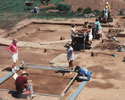A Collaboration Between Archaeology and Conservation: The Lead Coffin Project
“All archaeological excavation carries the professional obligation to preserve the materials recovered
through proper and appropriate conservation treatments” (Society for Historical Archaeology 1993).
While preparing for the rebuilding of a 17th-century Roman Catholic chapel at Historic St. Mary’s City, archaeologists conducted test excavations and discovered that nearly 500 people had been interred in the area. With the aid of a ground penetrating radar survey, it was found that three members of this early community had been buried in lead coffins within the limits of the building foundations. These unique coffins were discovered in the north transept of the chapel in 1990. They were reburied until a specialist team could be assembled.
 Chapel foundations exposed through archaeology. |
 Archaeological Field School students assisting in the excavation of the Chapel site. |
 Three lead coffins in situ at the chapel site. |
The Lead Coffin Project
Before Digging Begins
Conservation Starts in the Field
Sort and Stabilize
Understanding What You Have
An Ounce of Prevention
To Display or Not to Display
Sharing the Story
Learn more about the excavation of the coffins and some of the information gathered
by visiting the Project Lead Coffins pages.


